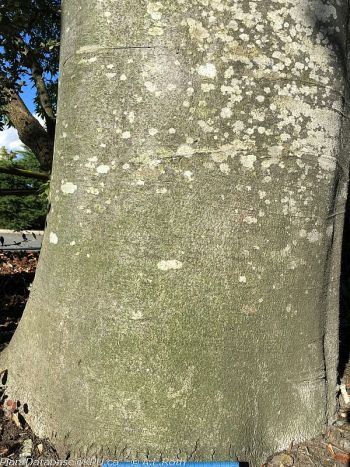Scientific Name:
Fagus sylvatica
Pronunciation:
FAY-gus sil-VAT-ih-kuh
Common Name:
European beech
Family Name:
Fagaceae
Plant Type:
Tree - deciduous
Key ID Features:
Leaves alternate, most blades broadly elliptic (some ovate or obovate), 5-9cm long x 3-6cm wide, glossy, (5-)7-9 pairs of parallel major veins, margin usually ciliate, undulate and entire, most petioles 5-12mm long;. Winter ID: mature bark smooth, dark grey, with a horizontal pattern (resemble an elephant's skin or leg); buds with few scales, narrowly conical, most 1-2.5cm long x 4-5mm wide, pointed, spear-like, divergent, reddish-brown with grey fuzz.
Habit:
Spreading
Form:
Oval - horizontal, Oval - vertical, Round
Texture:
Medium
Mature Height:
22 - 30m
Mature Spread:
15 - 25m
Growth Rate:
Moderate
Origin:
Europe
Hardiness Rating:
Zone 4: (-34 to -29 °C)
Exposure:
Full sun
Soil/Growing Medium:
Alkaline, Rocky or gravelly or dry, Well-drained
Water Use:
Moderate
Landscape Uses:
Fall interest, Hedge row, Herb, Screening, Sheared hedge, Specimen plant, Topiary, Wildlife food, Wind break
Additional Info:
Google. Cultivars shown may include F. 'Bornyensis' (large, green, weeping). See separate entries for other cultivars on campus.
Leaf Morphology:
Form:
Simple
Arrangement:
Alternate
Texture/Venation:
Soft flexible, Heavily veined, Pinnate venation
Surfaces:
Lustrous, Glandular hairs
Colour in Fall:
Green, Yellow, Red, Bronze
Shapes:
Elliptic, Obovate, Ovate
Apices:
Acute
Bases:
Cuneate
Margins:
Ciliate, Entire, Undulate (wavy)
Additional Info:
Spectacular fall colour
Inflorescence Type:
Catkin (ament)
Flower Morphology:
Monoecious plant
Number Of Petals:
0
Ovary Position:
Superior
Colour (petals):
Not showy, Green-yellow
Flower Scent:
None
Flower Time at Peak:
Apr, May
Additional Info:
Male florets in catkins; female flowers in pairs in leaf axils; each with single compound pistil involving two carpels each with one ovule
Bark Morphology:
Smooth
Bark or Stem Colour:
Grey
Leaf Bud Type:
Narrowly conical
Leaf Scar Shape:
Half-round
Organ Modifications:
Ectomycorrhizae, (mycobionts include species of Amanita, Boletus, Cantharellus, Hebeloma and Lactarius)
Propagation:
Seed, Hardwood cuttings, Grafting
Maintenance:
Low
Pest Susceptibility:
Aphids, Caterpillar or cutworm, Rodents (Pest resistant, Disease resistant)
Specific Pests:
Course(s):
- AARB 1012
- CLT Training
- HORT 1155
- Level 1 Apprenticeship
Location(s):
- (BHE) Boulevard by Hwy. 10 Eastend : 52, cv. Asplenifolia, Dawyck Gold, Dawyck Purple, Purple Fountain, Rotundifolia,
- (ONE) Overpass North side East : Atropurpurea Group & cv. Purple Fountain,
- (SGL) Sendell Gardens, Langley : cv. Purpurea Pendula
- (TFL) Turf Field Lab
- (TFLE) Turf Field Lab East : cv. Rotunifolia (on turf course)
- (TFLN) Turf Field Lab North : cv. Asplenifolia,
- (TFLW) Turf Field Lab West : cv. Purple Fountain





